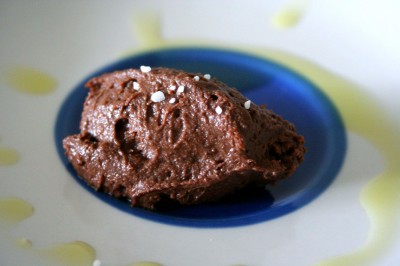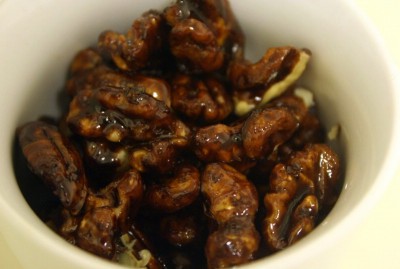
The term “culinary arts” is a misnomer, since cooking is as much science as it is creativity. One book that makes this clear is What Einstein Told His Cook: Kitchen Science Explained. The “cookbook” debunks kitchen myths in several sections, like “The Salt of the Earth,” “Sweet Talk,” and “The Fat of the Land.”
There’s even a couple pages devoted to my favorite food, chocolate. Chocolate, the book explains, has a luxurious texture because its natural fat (cocoa butter) melts at body temperature. To show off the wonderful properties of chocolate, the book provides a recipe for dairyless mousse. Keep in mind that cream-free doesn’t mean low-fat or vegan. The recipe has raw eggs, but that should be the least of your worries: a generous addition of olive oil more than makes up for the missing butterfat. Don’t knock olive oil in dessert till you’ve tried Otto’s olive oil gelato, chocolate toast with olive oil, and chocolate-covered olive oil potato chips. Yes, olive oil and chocolate go together! Think about it: the words fruity, floral, musky, spicy or nutty are commonly used to describe both of these products.
The idea of this mousse sounded good, but tastewise, it resembled a science project. It was as “buttery” as chocolate frosting: delicious, but not something to eat by the cupful. I recommend doubling the egg whites and/or replacing half the oil with boiling water (cool the chocolate mixture before adding it to the whites, of course). Hot water brings out the chocolate’s flavor. Contrary to popular belief, water and chocolate do go together, so long as there’s LOTS of water (at least 1 tablespoon of liquid for two ounces of chocolate, according to Cocolat).
To cut the richness of the dessert, sprinkle it with coarse salt. BTW, What Einstein Told His Cook says that artisan salt (like $33/pound fleur de sel) is virutally identical to shaker salt. Both are 99% sodium chloride. Fancy sea salt “tastes” better because its irregularly shaped flakes are crunchy and provide sudden bursts of saltiness.
For another kitchen experiment, you can actually whip chocolate like you do cream. All you need is chocolate, water and some know how, courtesy of In Praise of Sardines.
Olive Oil Chocolate Mousse
No, it will not collapse. No, it does not taste oily. Basque chef Teresa Barrenechea makes this silky chocolate mousse at her Manhattan restaurant, Marichu. “More and more, people don’t want to eat so much cream,” she says. “I don’t tell guests this dessert contains olive oil when I serve it. I wait until I hear them murmuring, ‘Mmh-mmmh.’ ” The chocolate flavor is intense, and there’s a hint of berry, but in spite of the generous amount of extra-virgin olive oil, its flavor is subtle.
6 ounces very good dark chocolate (such as Valrhona, El Rey or Lindt), chopped
3 large eggs, separated
2/3 cup powdered sugar, sifted after measuring
1/4 cup double-strength espresso coffee or 1 tablespoon instant espresso powder
2 tablespoons Chambord or Cointreau (optional)
3/4 cup extra-virgin olive oil
Melt the chocolate in a small bowl in the microwave or in a saucepan over very low heat. Let cool to lukewarm.
In a medium bowl, with an electric mixer, beat the egg yolks and sugar on medium speed until smooth. Beat in the coffee and Chambord just to combine. Then stir in the melted chocolate. Add the olive oil and mix well.
Thoroughly wash the beaters so that they are free of grease. In another medium bowl, beat the egg whites until almost stiff. Gently fold 1/3 of the egg whites into the chocolate mixture and whisk until patches of white disappear. Repeat, whisking the remaining egg whites into the chocolate mixture, 1/3 at a time, until patches of white disappear. Do not overmix.
Transfer the mousse into a pretty bowl or individual dessert dishes, cover and refrigerate until ready to eat. Serve cold. Makes 6 servings.




